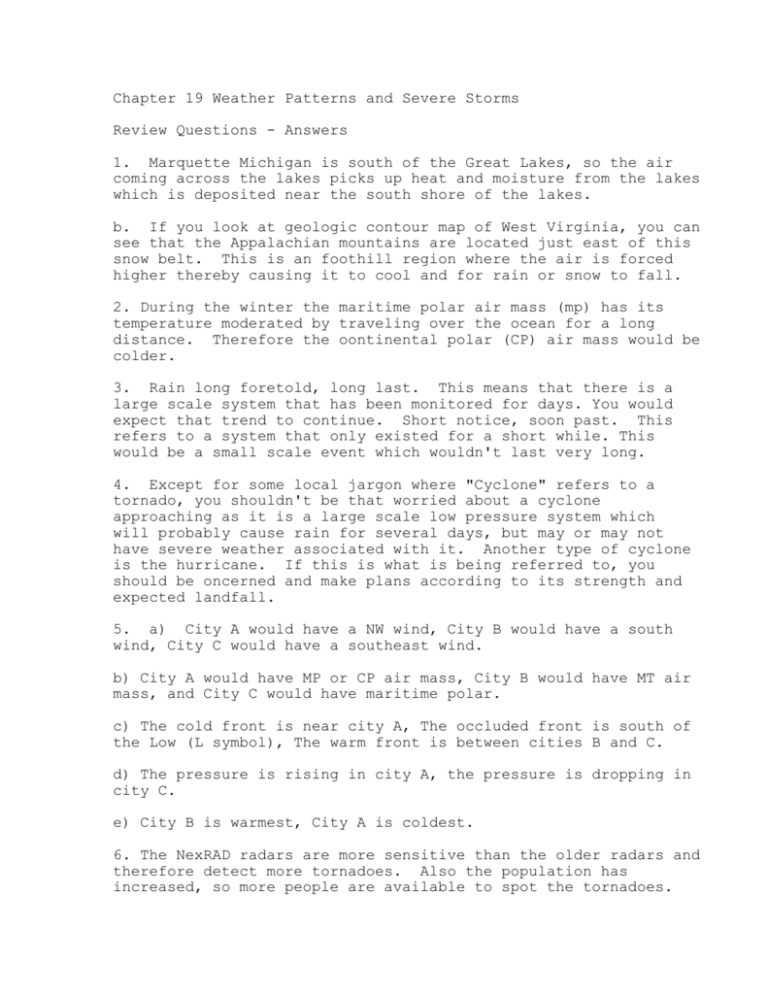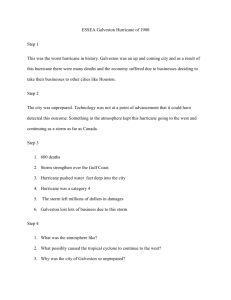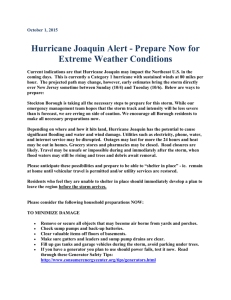Weather Patterns & Severe Storms: Review Questions & Answers
advertisement

Chapter 19 Weather Patterns and Severe Storms Review Questions - Answers 1. Marquette Michigan is south of the Great Lakes, so the air coming across the lakes picks up heat and moisture from the lakes which is deposited near the south shore of the lakes. b. If you look at geologic contour map of West Virginia, you can see that the Appalachian mountains are located just east of this snow belt. This is an foothill region where the air is forced higher thereby causing it to cool and for rain or snow to fall. 2. During the winter the maritime polar air mass (mp) has its temperature moderated by traveling over the ocean for a long distance. Therefore the oontinental polar (CP) air mass would be colder. 3. Rain long foretold, long last. This means that there is a large scale system that has been monitored for days. You would expect that trend to continue. Short notice, soon past. This refers to a system that only existed for a short while. This would be a small scale event which wouldn't last very long. 4. Except for some local jargon where "Cyclone" refers to a tornado, you shouldn't be that worried about a cyclone approaching as it is a large scale low pressure system which will probably cause rain for several days, but may or may not have severe weather associated with it. Another type of cyclone is the hurricane. If this is what is being referred to, you should be oncerned and make plans according to its strength and expected landfall. 5. a) City A would have a NW wind, City B would have a south wind, City C would have a southeast wind. b) City A would have MP or CP air mass, City B would have MT air mass, and City C would have maritime polar. c) The cold front is near city A, The occluded front is south of the Low (L symbol), The warm front is between cities B and C. d) The pressure is rising in city A, the pressure is dropping in city C. e) City B is warmest, City A is coldest. 6. The NexRAD radars are more sensitive than the older radars and therefore detect more tornadoes. Also the population has increased, so more people are available to spot the tornadoes. 7. a) Hurriane Andrew was a class 4 storm. Hurricane Camille was a class 5 storm. and Hurricane Katrina was a class 5 storm, but it was after Hurricane Andrew. If this hurriane Gaston were the the first class 5 to hit the U. S. after Hurricane Andrew, then the total would be 2: hurricane Camille and hurricane Gaston in 2016. b. Hurricane Gaston would start off very likely as a cold core low pressure system, would develop into a warm core low and then start to pickup speed and produce more rainfall. It would have been named as a tropical storm at wind speeds between 38 and 74 miles/hour. c. Gaston is forecast to hit east of Houston so Houston should not bare the brunt of the storm, but nevertheless should prepare for the storm if authorities give warnings. The heaviest rainfall ever received in Houston was when a tropical storm took this path (40 inches of rain in 48 hours from tropical storm Claudette in 1979. So you should always be aware that the unexpected can happen. d. Tornadoes and heavy rain. 8. a) The winds were higher on thursday before the storm made landfall. b) It moved about 350 miles in 24 hours. 14.6 miles/hour.




